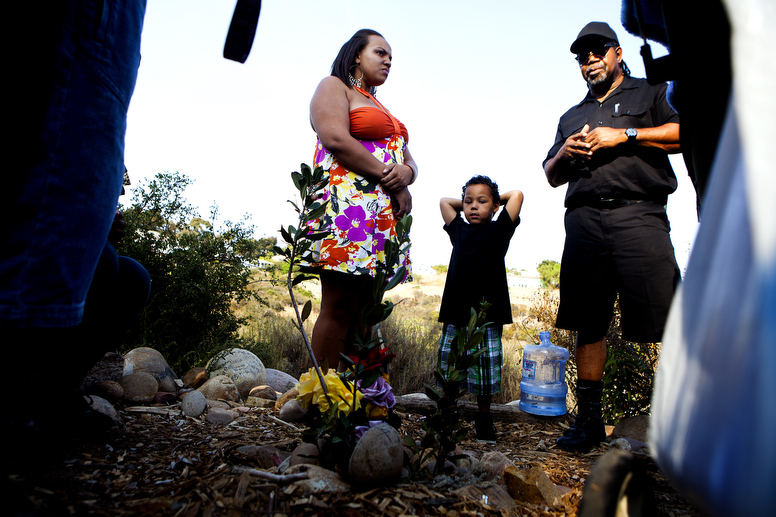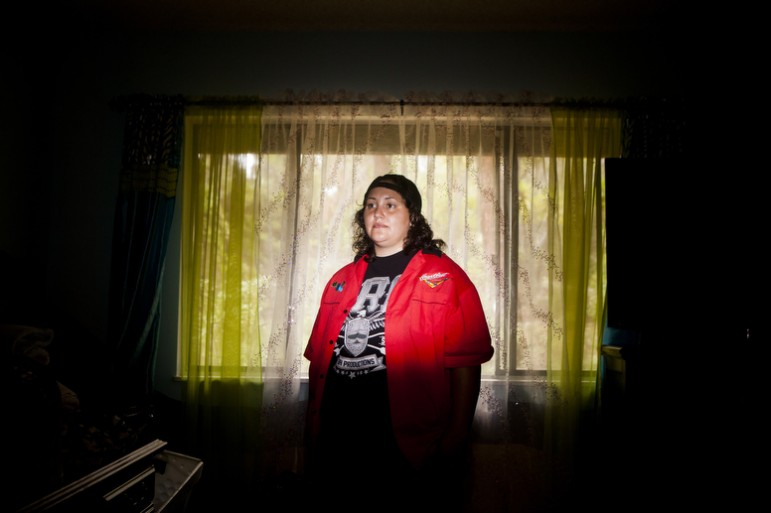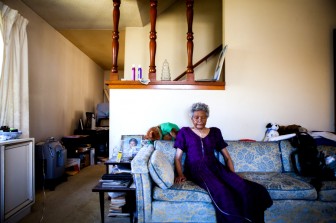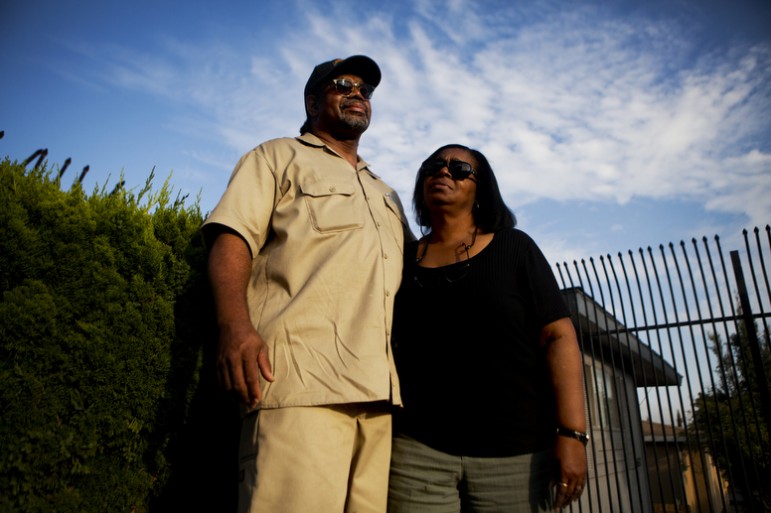
Family members of Rickquese McCoy share memories of him over a memorial in a canyon near their home. McCoy was shot and killed in June 2012. It took fire crews 12 minutes to arrive at his aid. | Photo Credit: Sam Hodgson
Rickquese McCoy decided the bonfire could wait.
It was after 10 p.m. on a Saturday last June, and teenagers along the 2600 block of 44th Street in City Heights had begun piling into cars for a bonfire at Mission Beach. McCoy, 18, stepped out of his friend’s Pontiac Grand Am to talk with a neighbor instead. McCoy had lent her his cigarette lighter and wanted it back. He didn’t mind being a little late.
McCoy and the neighbor chatted in a nearby apartment complex’s common area. She teased him about keeping the lighter, which was pink. About 10 feet away, McCoy’s friend Timothy Walker spoke with his uncle, Stephen McClendon, who also lived on the block.
As the friends talked, three men in dark clothing approached the complex. The neighbor whispered to McCoy, asking who they were. McCoy shrugged.
The men reached the group and opened fire.
They shot McClendon and Walker. Both fell to the ground. Two shots struck McCoy, in the buttocks and back. One bullet broke two ribs and ripped through his left lung. McCoy ran and collapsed in an alley behind the apartment complex, about a football field from where the shooting began.
Calls to 911 poured in. Police arrived, radioing to the Fire-Rescue Department for medical help. An ambulance came first, seven minutes after the department learned of the incident. A fire truck arrived a minute later. They both went to the front of the complex for Walker and McClendon. They didn’t know about McCoy in the alley, the department later told his family.
Firefighters at the scene eventually learned there was a third victim and sent a paramedic to McCoy. But rescuers couldn’t give McCoy the care he needed until another fire engine came, 12 minutes after the Fire-Rescue Department received the first 911 call.
When firefighters arrived, they found Lennece Chambers, whose apartment opens into the alley, holding McCoy’s hand. At first she had watched McCoy try to get up. Then, after a while, Chambers saw blood trickle out McCoy’s nose. She asked him if he knew Jesus.
“When he got in the ambulance, I already knew right then and there he wasn’t going to make it,” Chambers said. “You could see the life just going.”
McCoy lost his pulse when he arrived at Scripps Mercy Hospital in Hillcrest. Doctors began emergency surgery, but gave up within minutes. Rickquese McCoy had bled to death.
Help for McCoy should have been there sooner. He was shot less than a half-mile from Home Avenue, where the city’s newest fire station should have been built by now. City leaders pledged to put one there because first responders don’t get to emergencies fast enough.
By their own standard, first responders have arrived late across the city more than 37,000 times to cardiac arrests, chokings, shootings and other highest-priority incidents during a 21-month period ending in March, a Voice of San Diego analysis of delayed responses found. That’s an average of more than two times an hour, every day. If you add lower-priority incidents to the list, the rate almost doubles.
Nowhere in San Diego has a greater chance for delays than five neighborhoods within 9 ½ square miles south and east of downtown, including some of the poorest and brownest parts of the city. A recent consultant study found that the neighborhood surrounding Home Avenue had the highest risk of a late response, followed by Paradise Hills, College Area, Skyline and Encanto.
Twenty months ago, city leaders committed to building fire stations in all five neighborhoods by the middle of 2017. They haven’t put a dime toward funding any of them.
When you dial 911 with a medical emergency in the city of San Diego, the Fire-Rescue Department responds. Medical incidents, not fires, make up 87 percent of the department’s more than 100,000 annual 911 dispatches.
First responders aim to arrive at medical emergencies within seven minutes and 30 seconds, nine times out of 10. They fall far short of that goal, even though the department relaxed its standards 20 months ago. Before then, first responders were supposed to arrive within six minutes, nine times out of 10, a nationally recommended target. The department couldn’t meet that goal even half the time. Fire officials argue they can’t possibly reach the newer target without more resources.
Time matters for gunshot wounds like McCoy’s, and for cardiac arrests, chokings and other emergencies. For every minute someone doesn’t receive emergency medical help after collapsing from cardiac arrest, that person’s chance of survival goes down 7 to 10 percent.
Triple shootings don’t happen often in San Diego. But other traumas do. In the neighborhoods most at risk for a long emergency response, the delays can provide a painful punctuation to horrifying incidents.
 Cherish Lomeli | Photo Credit: Sam Hodgson |
Last November, 28-year-old Cherish Lomeli was scrubbing the gas stove in her Encanto home when the cleaner she was using ignited. A fireball exploded in her face. Two and a half inches of her hairline burned off. So did her eyebrows and nose hair.
Her wife called 911, and Lomeli sat in the shower running cold water over her face.
“It pretty much felt like someone poured acid on my face and down my throat,” Lomeli said.
Lomeli waited more than 11 minutes for first responders to arrive. She ended up in the hospital for two days with burns to her face and lungs.
During the region-wide blackout in fall 2011, 81-year-old Rosemary Womack awoke from a nap to find her oxygen machine not working. Womack, who lives alone in her Skyline home, suffers from chronic pulmonary disease and needs extra oxygen all the time. She called 911. She waited more than 15 minutes for someone to get there and give her the oxygen she needed.
 Rosemary Womack | Photo Credit: Sam Hodgson |
Womack, who also has glaucoma, estimated she dialed 911 about a half dozen times over the past 18 months.
“I just thank God they come when they do,” Womack said. “And I worry about the time when they might take too long.”
In March 2012, two roommates of 51-year-old Mark Ledesma found him passed out in his room in their Paradise Hills home and dialed 911. Ledesma had likely died of a methamphetamine overdose and cardiac arrest before the 911 call, but the roommates didn’t know that.
In an excruciating 11-minute 911 recording, a dispatcher instructs the roommates to give Ledesma CPR and tells them help is on the way.
“They’re coming with lights and sirens,” the dispatcher says.
After five minutes on the phone, a roommate says, “Fucking hurry up please.”
After seven minutes she screams, “Where the fuck is the ambulance at?” between sobs.
After nine minutes, she screams, “Where the fuck is the ambulance at?” again.
More 911 calls resemble Ledesma’s than true life-and-death situations, said Jim Dunford, a physician and the city’s emergency medical director. In Ledesma’s case, the response time likely wouldn’t have affected whether he lived or died. But it did matter to those in the room with him.
Any practical investment in getting paramedics to medical emergencies faster likely will only save a small number of lives each year, Dunford said.
“We try to meet the collective needs of the community, realizing there is no such thing as an ambulance or fire engine arriving too soon,” Dunford said.
But any investment also would help people cope with the dread of being alone when disaster strikes.
“What we’re really buying here is a psychological insurance plan,” he said. “That if something bad happens, someone will be in the room.”
By now, the chance of a long emergency response in high-risk neighborhoods should be lower. It isn’t.
After the response time study came out, the City Council unanimously passed a plan to build all five top-priority stations within five years. They estimated the price tag would be $49 million, including the cost of the firefighters to work there. Twenty months later, no money has gone toward any of the stations.
Mayor Bob Filner has broken a promise on the new fire facilities, too.
In Filner’s first press conference after his November election, he said he would spend more than $10 million immediately to help build the Home Avenue and Paradise Hills stations. He didn’t.
Money has been tight in San Diego for years. And the city has thrown some cash the Fire-Rescue Department’s way since the response time study was released. It restored idled fire engines that had been browned out during the nadir of the city’s financial crisis and funded a fire station in Mission Valley to replace a trailer-turned-makeshift-station currently in Qualcomm Stadium’s parking lot.
But city leaders have prioritized other things as well. The city is spending tens of millions of dollars this year on new programs and initiatives. It also borrowed $35 million to build and rehab city facilities. A new library in Skyline is on the list, but a new fire station there, or in any of the other most at-risk neighborhoods, didn’t make the cut.
Story continues below.

Ricky and Patricia McCoy, grandparents of Rickquese McCoy, were held back from going to the hospital while police officers worked the crime scene. Rickquese died soon after he arrived at the hospital. | Photo Credit: Sam Hodgson
Patricia McCoy was showering when she heard the gunshots. The mariachi music from outside her neighbor’s house stopped. There was silence, then screams.
Her nephew banged on the bathroom door. Rickquese, her grandson, was down. She threw on her clothes and, sopping wet and barefoot, ran as fast as she could across the street and down the block to the alley. She saw Rickquese lying in his own blood, talking and scared.
Patricia McCoy, who usually needs a cane, hurried back to her house to get her grandson’s insurance card for the hospital. But police officers held her and her husband at their house while cops worked the crime scene. She didn’t make it to the hospital, and found out on the phone that Rickquese had died.
Patricia McCoy had raised Rickquese like he was her own son. All his life, Rickquese had struggled in school and had minor skirmishes with the law, but he had just made the honor roll for the first time and was a few credits short of graduating high school.
“He didn’t deserve to die like a dog in the alley,” Patricia McCoy said. “We didn’t deserve to have to watch him.”
Later that night, Patricia McCoy started having trouble breathing. She suffers from high blood pressure. Worried family members dialed 911.
It took first responders almost nine and a half minutes to show up to her house. They were late for her, too.
